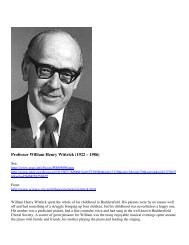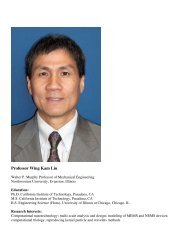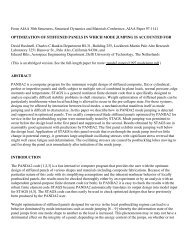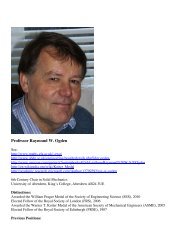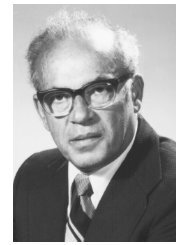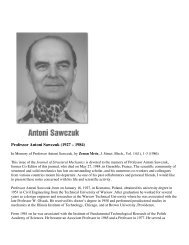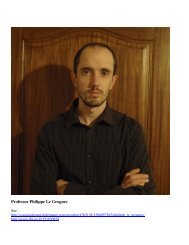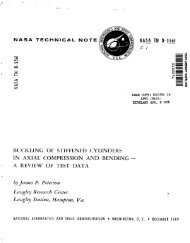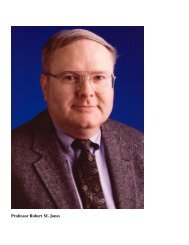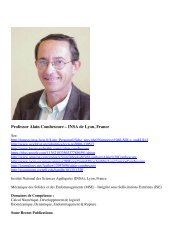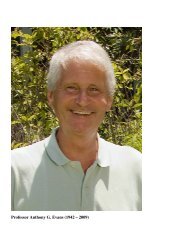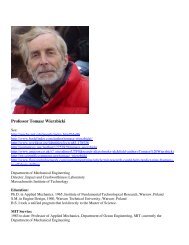Professor Juan Carlos Simo - Shellbuckling.com
Professor Juan Carlos Simo - Shellbuckling.com
Professor Juan Carlos Simo - Shellbuckling.com
Create successful ePaper yourself
Turn your PDF publications into a flip-book with our unique Google optimized e-Paper software.
<strong>Professor</strong> <strong>Juan</strong> <strong>Carlos</strong> <strong>Simo</strong><br />
Department of Applied Mechanics<br />
Stanford University<br />
See:<br />
http://www.worldcat.org/identities/lccn-n88-189412<br />
http://orlabs.oclc.org/identities/lccn-n88-189412/<br />
http://www.worldcat.org/title/in-memory-of-professor-juan-carlos-simo/oclc/437085605<br />
Selected Publications:<br />
<strong>Simo</strong>, J. C., and Marsden, J. E., “On the Rotated Stress Tensor and the Material Version of the Doyle–Ericksen<br />
Formula,” Archives of Rational Mechanics and Analysis, Vol. 86, 1984, pp. 213–231.<br />
<strong>Simo</strong>, J. C., and Taylor, R. L., “Consistent Tangent Operators for Rate Independent Elasto-Plasticity,”<br />
Computational Methods in Applied Mechanical Engineering, Vol. 48, 1985, pp. 101–118.<br />
J.C. <strong>Simo</strong>, 'A finite strain beam formulation. The three dimensional dynamics problem'. Part I Computer<br />
Methods in Applied Mechanics and Engineering, 42, pp. 55-70, (1985).<br />
J. C. <strong>Simo</strong> and R. L. Taylor, “A Return Mapping Algorithm for Plane Stress Elastoplasticity,” International<br />
Journal for Numerical Methods in Engineering, v. 22, p. 649-670, 1986.<br />
<strong>Simo</strong> J.C., Vu-Quoc L., A three-dimensional finite strain rod model, Part II: Computer aspects, Comput.<br />
Methods Appl. Mech. Engrg., 1986; 58; 79-116.<br />
<strong>Simo</strong>, J.C., Hughes, T.J.R. On the Variational Formulation of Assumed Strain Methods, J. Appl. Mech., 53, 51-<br />
54 (1986).<br />
<strong>Simo</strong>, J. C., “A Framework for Finite Strain Elasto-Plasticity Based on Maximum Plastic Dissipation and<br />
Multiplicative De<strong>com</strong>position: Part I. Continuum Formulation,” Computational Methods in Applied Mechanical<br />
Engineering, Vol. 66, 1988, pp. 199– 219.<br />
<strong>Simo</strong>, J. C., “A Framework for Finite Strain Elasto-Plasticity Based on Maximum Plastic Dissipation and<br />
Multiplicative De<strong>com</strong>position: Part II. Computational aspects,” Computational Methods in Applied Mechanical<br />
Engineering, Vol. 68, 1988, pp. 1– 31<br />
<strong>Juan</strong> C. <strong>Simo</strong>, Jerrold E. Marsden and P. S. Krishnaprasad, “The Hamiltonian structure of nonlinear elasticity:<br />
The material and convective representations of solids, rods, and plates”, Archive for Rational Mechanics and<br />
Analysis, Vol. 104, No. 2, 1988, pp. 125-183, doi: 10.1007/BF00251673<br />
PARTIAL INTRODUCTION: It is our belief that a thorough understanding of the mathematical underpinnings<br />
of elasticity is crucial to its analytical and numerical implementation. For example, in the analysis of rotating<br />
structures, the coupling of the equations for geometrically inexact models obtained by linearization or other
approximations with those for rotating rigid bodies can easily lead to misleading artificial “softening” effects<br />
that can significantly alter numerical results. …. In this paper we consider fully nonlinear geometrically exact<br />
models for rods, plates (and shells) which take into account shear and torsion as well as the usual bending<br />
effects in traditional rod and plate models. These models can be obtained either from the three-dimensional<br />
theory by a systematic use of projection methods … or by a direct approach within the context of Cosserat<br />
continuum…<br />
J. C. <strong>Simo</strong> and D. D. Fox (Division of Applied Mechanics, Department of Mechanical Engineering, Stanford<br />
University, Stanford, CA, U.S.A.), “On a stress resultant geometrically exact shell model. Part I: Formulation<br />
and optimal parametrization”, Computer Methods in Applied Mechanics and Engineering, Vol. 72, No. 3,<br />
March 1989, pp. 267-304, doi:10.1016/0045-7825(89)90002-9<br />
ABSTRACT: (no abstract given)<br />
J.C. <strong>Simo</strong>, D.D. Fox and M.S. Rifai (Division of Applied Mechanics, Department of Mechanical Engineering,<br />
Stanford University,Stanford, CA 94304, U.S.A.), “On a stress resultant geometrically exact shell model. Part<br />
II: The linear theory; Computational aspects”, Computer Methods in Applied Mechanics and Engineering, Vol.<br />
73, No. 1, April 1989, pp. 53-92, doi:10.1016/0045-7825(89)90098-4<br />
ABSTRACT: Computational aspects of a linear stress resultant (classical) shell theory, obtained by systematic<br />
linearization of the geometrically exact nonlinear theory, considered in Part I of this work, are examined in<br />
detail. In particular, finite element interpolations for the reference director field and the linearized rotation field<br />
are constructed such that the underlying geometric structure of the continuum theory is preserved exactly by the<br />
discrete approximation. A discrete canonical, singularity-free mapping between the five and the six degree of<br />
freedom formulation is constructed by exploiting the geometric connection between the orthogonal group<br />
(SO(3)) and the unit sphere (S2). The proposed numerical treatment of the membrane and bending fields, based<br />
on a mixed Hellinger-Reissner formulation,provides excellent results for the 4-node bilinear isoparametric<br />
element. As an example, convergent results are obtained for rather coarse meshes in fairly demanding,<br />
singularity-dominated, problems such as the classical rhombic plate test. The proposed theory and finite element<br />
implementation are evaluated through an extensive set of benchmark problems. The results obtained with the<br />
present approach exactly match previous solutions obtained with state-of-the-art implementations based on the<br />
so-called degenerated solid approach.<br />
<strong>Simo</strong>, J. C., Fox, D. D., and Rifai, M. S., “Geometrically Exact Stress Resultant Shell Models: Formulation and<br />
Computational Aspects of the Non-linear Theory,” Analytical and Computational Models of Shells, edited by<br />
A. K. Noor, T. Belytschko, and J. C. <strong>Simo</strong>, American Society of Mechanical Engineers, New York, 1989, pp.<br />
161–190.<br />
J. C. <strong>Simo</strong>, S. Rifai, D.D. Fox, On a stress resultant geometrically exact shell model. PartI V: variable thickness<br />
shells with through-the-thickness stretching, Comput. Methods Appl. Mech. Engrg. 81 (1990) 91–126.<br />
<strong>Simo</strong> JC, Rifai MS (1990) A Class of mixed assumed strain methods and the methods of in<strong>com</strong>patible modes.<br />
Int. J. Num. Meth. Eng. 29:1595-1638<br />
J.C. <strong>Simo</strong>, D.D. Fox and M.S. Rifai (Division of Applied Mechanics, Department of Mechanical Engineering,<br />
Stanford University,Stanford, CA 94304, U.S.A.), “On a stress resultant geometrically exact shell model. Part<br />
III: Computational aspects of the nonlinear theory”, Computer Methods in Applied Mechanics and Engineering,<br />
Vol. 79, No. 1, March 1990, pp. 21-70, doi:10.1016/0045-7825(90)90094-3
ABSTRACT: Computational aspects of a geometrically exact stress resultant model presented in Part I of this<br />
work are considered in detail. In particular, by exploiting the underlying geometric structure of the model, a<br />
configuration update procedure for the director (rotation) field is developed which is singularity free and exact<br />
regardless the magnitude of the director (rotation) increment. Our mixed finite element interpolation for the<br />
membrane, shear and bending fields presented in Part II of this work are extended to the finite deformation case.<br />
The exact linearization of the discrete form of the equilibrium equations is derived in closed form. The<br />
formulation is then illustrated by a <strong>com</strong>prehensive set of numerical experiments which include bifurcation and<br />
post-buckling response, as well as <strong>com</strong>parisons with closed form solutions and experimental results.<br />
J. C. <strong>Simo</strong>, M. S. Rifai and D. D. Fox (Division of Applied Mechanics, Department of Mechanical Engineering,<br />
Stanford University, Stanford, CA, U.S.A.), “On a stress resultant geometrically exact shell model. Part IV:<br />
Variable thickness shells with through-the-thickness stretching”, Computer Methods in Applied Mechanics and<br />
Engineering, Vol. 81, No. 1, July 1990, pp. 91-126, doi:10.1016/0045-7825(90)90143-A<br />
ABSTRACT: This paper in concerned with the extension of the shell theory and numerical analysis presented in<br />
Part I, II and III to include finite thickness stretch and initial variable thickness. These effects play a significant<br />
role in problems involving finite membrane strains, contact, concentrated surface loads and delamination (in<br />
<strong>com</strong>posite shells). We show that a direct numerical implementation of the standard single extensible director<br />
shell model circumvents the need for rotational updates, but exhibits numerical ill-conditioning in the thin shell<br />
limit. A modified formulation obtained via a multiplicative split of the director field into an extensible and<br />
inextensible part is presented, which involves only a trivial modification of the weak form of the equilibrium<br />
equations considered in Part III, and leads to a perfectly well-conditioned formulation in the thin-shell limit. In<br />
sharp contrast with previous attempts in the context of the degenerated solid approach, the thickness stretch is<br />
an independent field, not a dependent variable updated iteratively via the plane stress condition. With regard to<br />
numerical implementation, an exact update procedure which automatically ensures that the thickness stretch<br />
remains positive is presented. For the present theory, standard displacement models would exhibit ‘locking’ in<br />
the in<strong>com</strong>pressible limit as a result of the essentially three-dimensional character of the constitutive equations.<br />
A mixed formulation is described which circumvents this difficulty. Numerical examples are presented that<br />
illustrate the effects of the thickness stretch, the performance of the proposed mixed interpolation, and the wellconditioned<br />
response exhibited by the present approach in the thin-shell (inextensible director) limit.<br />
P. Wriggers and J.C. <strong>Simo</strong>, A general procedure for the direct <strong>com</strong>putation of turning and bifurcation points,<br />
Int. J. Num. Meth. Eng. 30, 155-176 (1990).<br />
J.C. <strong>Simo</strong> and J.G. Kennedy (Division of Applied Mechanics, Department of Mechanical Engineering, Stanford<br />
University, Stanford, California, USA), “On a stress resultant geometrically exact shell model. Part V.<br />
Nonlinear plasticity: formulation and integration algorithms”, Computer Methods in Applied Mechanics and<br />
Engineering, Vol. 96, No. 2, April 1992, pp. 133-171, doi:10.1016/0045-7825(92)90129-8<br />
ABSTRACT: The continuum basis and numerical implementation of a finite deformation plasticity model<br />
formulated within the framework of the geometrically exact shell model presented in Parts I and III of this<br />
work, is discussed in detail. The model is formulated entirely in stress resultants, and hence the expensive<br />
integration through the thickness associated with the traditional degenerated solid approach is entirely bypassed.<br />
In particular, the classical Ilyushin-Shapiro plasticity model for shells is extended to ac<strong>com</strong>modate<br />
kinematic and isotropic hardening, and consistently formulated to ac<strong>com</strong>modate finite deformation. The<br />
corresponding closest-point-projection return mapping algorithm is shown to reduce to the solution of a system<br />
of two nonlinear scalar equations, and proved to be amenable to exact linearization leading to a closed form<br />
expression of the consistent elastoplastic tangent moduli. Numerical simulations are presented and <strong>com</strong>parisons
with exact and approximate solutions are made which demonstrate the excellent performance of the proposed<br />
methodology.<br />
J. C. <strong>Simo</strong> (Division of Applied Mechanics, Department of Mechanical Engineering, Stanford University,<br />
Stanford, CA 94305, USA), “On a stress resultant geometrically exact shell model. Part VII: Shell intersections<br />
with 5/6-DOF finite element formulations”, Computer Methods in Applied Mechanics and Engineering, Vol.<br />
108, Nos. 3-4, September 1993, pp. 319-339, doi:10.1016/0045-7825(93)90008-L<br />
ABSTRACT: If the mid-surface of a shell is smooth, the classical theory describes the orientation of the<br />
director field attached to the mid-surface by two independent (rotational) degrees of freedom. At a shell<br />
intersection, where this smoothness assumption no longer holds, it is shown that the director field in the full<br />
nonlinear continuum shell equations must be necessarily described by three degrees of freedom. This added<br />
degree of freedom, however, is totally unrelated to the so-called drill rotation, widely used as a means of<br />
tackling the shell intersection problem. A <strong>com</strong>putational procedure involving a trivial modification of the global<br />
singularity-free update procedure described in Part III of this work is described, which <strong>com</strong>pletely resolves the<br />
shell intersection problem without introducing ‘drill springs’ or related ad-hoc devices. The proposed approach<br />
leaves unchanged standard finite element formulations in terms of 5 DOF/node, affects only the global update<br />
formulae and exhibits excellent performance, as illustrated by representative numerical simulations.<br />
<strong>Simo</strong>, J. C. and Hughes, T. J. R., 1998, “Computational Inelasticity: Interdisciplinary Applied Mathematics”,<br />
Vol. 7, Ed. Springer-Verlag New York, Inc., 404 p.<br />
<strong>Simo</strong>, J.C., and R.L. Taylor, "Quasi-In<strong>com</strong>pressible Finite Elasticity in Principal Stretches: Continuum Basis<br />
and Numerical Algorithms," Comp. Meths. Appl. Mechs. Eng., 85, pp. 273-310, 1991<br />
J.C. <strong>Simo</strong>, 'The symmetric Hessian for geometrically nonlinear models in solid mechanics: Intrinsic definition<br />
and geometric interpretation', Computer Methods in Applied Mechanics and Engineering, 96, pp. 189- 200,<br />
(1992).<br />
C.R. Steele, Marie-Louise Steele and J. C. <strong>Simo</strong>, “In memory of <strong>Professor</strong> <strong>Juan</strong> <strong>Carlos</strong> <strong>Simo</strong>”, International<br />
Journal of Solids and Structures, Vol. 33, No. 20-22, 1996<br />
Computational inelasticity by J. C <strong>Simo</strong> ( Book )<br />
13 editions published between 1997 and 2008 in English and held by 426 libraries worldwide<br />
"This book describes the theoretical foundations of inelasticity, its numerical formulation and implementation.<br />
The subject matter described herein constitutes a representative sample of state-of-the-art methodology<br />
currently used in inelastic calculations." "Computational Inelasticity will be of great interest to researchers and<br />
graduate students in various branches of engineering, especially civil, aeronautical and mechanical, and applied<br />
mathematics."--Jacket.<br />
Dynamics and control of multibody systems : proceedings of the AMS-IMS-SIAM Joint Summer Research<br />
Conference held July 30-August 5, 1988, with support from the National Science Foundation by AMS-IMS-<br />
SIAM Joint Summer Research Conference in the Mathematical Sciences on Control Theory and Multibody<br />
Systems ( Book )<br />
1 edition published in 1989 in English and held by 207 libraries worldwide
Analytical and <strong>com</strong>putational models of shells : presented at the Winter Annual Meeting of the American<br />
Society of Mechanical Engineers, San Francisco, California, December 10-15, 1989 ( Book )<br />
2 editions published in 1989 in English and held by 99 libraries worldwide<br />
Stability of coupled rigid body and geometrically exact rods : block diagonalization and the energy-momentum<br />
method by J. C <strong>Simo</strong> ( Book )<br />
3 editions published between 1989 and 1990 in English and held by 12 libraries worldwide<br />
Dynamics and control of multibody systems proceedings of the AMS-IMS-SIAM joint summer conference held<br />
July 30-August 5, 1988, with support from the National Science Foundation by AMS-IMS-SIAM Joint Summer<br />
Research Conference in the Mathematical Sciences on Control Theory and Multibody Systems ( Book )<br />
1 edition published in 1989 in English and held by 9 libraries worldwide<br />
Mechanics: from theory to <strong>com</strong>putation : essays in honor of <strong>Juan</strong>-<strong>Carlos</strong> <strong>Simo</strong> ; papers invited by Journal of<br />
nonlinear science editors ( Book )<br />
1 edition published in 2000 in English and held by 5 libraries worldwide<br />
Nonlinear stability of geometrically exact rods by the energy-momentum method by J. C <strong>Simo</strong> ( Book )<br />
2 editions published in 1988 in English and held by 3 libraries worldwide<br />
A modified cap model : closest point solution algorithms by G Hofstetter ( Book )<br />
2 editions published between 1909 and 1989 in English and held by 3 libraries worldwide



